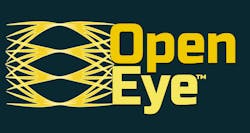Open Eye Consortium releases analog 50-Gbps LR1 and LR4 specifications

The Open Eye Consortium (Open Eye MSA), which is dedicated to developing specifications for analog-based PAM4 Ethernet modules, has released a pair of new specifications. The specs describe 50-Gbps per lane LR1 and LR4 design parameters for 10-km reach based on the CWDM4 wavelength grid over a single-mode fiber. The 50-Gbps LR1 single-mode specification is available to the public, while the 4x50-Gbps LR4 single-mode specification currently is available only to MSA members.
The new specifications target 53-Gbps SFP28 Long-Reach (LR) and 200-Gbps QSFP Long Reach (LR) optical module designs for 5G mobile, enterprise and data center networking applications. They complement the MSA’s prior specifications for such form factors as well as for 100G DSFP, 100G SFP-DD, and 400G QSFP-DD and OSFP modules (see “Open Eye Consortium releases PAM4 53-Gbps single-mode transceiver module specification” and "Open Eye Consortium completes specifications for 53G-per-lane multimode SR4, single-mode LR modules"). All focus on analog-based designs that obviate the need for a DSP. The analog CDR approach results in a less expensive and power-hungry design, the MSA members assert.
The MSA has 38 members, including four new contributing companies: Credo Semiconductor, Fuji Xerox, Hisense, and Lumentum. Further information is available at https://www.openeye-msa.org/.
For related articles, visit the Optical Technologies Topic Center.
For more information on optical modules and suppliers, visit the Lightwave Buyer’s Guide.
To stay abreast of optical communications technology, subscribe to Lightwave’s Enabling Technologies Newsletter.

Stephen Hardy | Editorial Director and Associate Publisher, Lightwave
Stephen Hardy is editorial director and associate publisher of Lightwave and Broadband Technology Report, part of the Lighting & Technology Group at Endeavor Business Media. Stephen is responsible for establishing and executing editorial strategy across the both brands’ websites, email newsletters, events, and other information products. He has covered the fiber-optics space for more than 20 years, and communications and technology for more than 35 years. During his tenure, Lightwave has received awards from Folio: and the American Society of Business Press Editors (ASBPE) for editorial excellence. Prior to joining Lightwave in 1997, Stephen worked for Telecommunications magazine and the Journal of Electronic Defense.
Stephen has moderated panels at numerous events, including the Optica Executive Forum, ECOC, and SCTE Cable-Tec Expo. He also is program director for the Lightwave Innovation Reviews and the Diamond Technology Reviews.
He has written numerous articles in all aspects of optical communications and fiber-optic networks, including fiber to the home (FTTH), PON, optical components, DWDM, fiber cables, packet optical transport, optical transceivers, lasers, fiber optic testing, and more.
You can connect with Stephen on LinkedIn as well as Twitter.